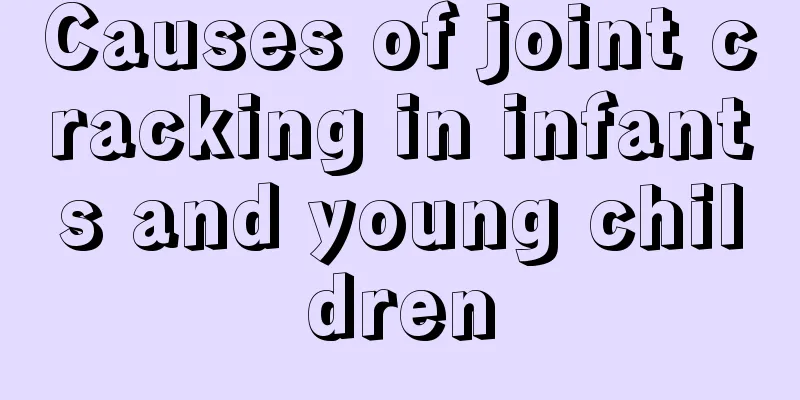Causes of joint cracking in infants and young children

|
Snapping joints are something that often happens to adults, but many people are misled into thinking that only adults experience this phenomenon. In fact, children may also experience snapping joints. Many parents can inadvertently hear their children's joints snapping during parenting. They are surprised at the symptoms at first, but if it happens frequently, they will be very worried about the symptoms of their children. So what exactly is the reason for the snapping joints in infants and young children? 1. Rheumatic fever: In addition to rheumatic heart disease, it is often accompanied by varying degrees of joint swelling and pain. The pain is short-lived, sometimes subsiding in just 1 to 2 days. It is migratory pain and leaves no deformity or sequelae in the joints. 2. Rheumatoid arthritis: Most cases occur between the ages of 4 and 10. The condition can be acute, with symptoms such as fever and joint pain, or chronic. The pain in a joint may last a long time, or a sudden fever may accelerate the progression of the disease, eventually invading joints throughout the body and causing joint deformities. 3. Allergic purpuric arthritis: Clinically, one or more joints are commonly swollen and painful, and purpura of the skin occurs at the same time. A small number of people experience purpura at different times and it is easy to ignore it. If it is not treated in time and the disease is not suppressed, it may lead to kidney damage. 4. Acute suppurative arthritis: more common in infants and young children, sometimes secondary to injuries or other infectious diseases. The onset is acute, with one or more joints becoming red, swollen and painful, accompanied by symptoms such as fever, irritability, and loss of appetite. 5. Acute hip synovitis: Most children are 3 to 10 years old, and often have a history of upper respiratory tract infection 1 to 3 weeks before the onset of the disease. The main symptoms are mild pain in one thigh and knee joint. The pain worsens during movement and the patient may limp. The disease heals on its own after 3 to 4 weeks. The ligaments of young infants are relatively weak, the articular sockets are shallow, the ligaments around the joints are relatively loose, the bones are soft, and there is cartilage at the ends of long bones. A similar "snap" may occur when the primary joints flex and extend, the same sound you hear when you pick up your baby. As children get older, their ligaments become stronger and their muscles develop, and the popping sound gradually disappears. Even some adults may experience popping sounds if their joints do not move normally, just like the crisp popping sounds that occur when squeezing their knuckles. If there are no special symptoms, this is completely normal. If the child's joint clicking occurs in the shoulder blade area, the possibility of "snapping shoulder" cannot be ruled out. "Snapping shoulder" refers to the snapping sound in the shoulder area caused by friction between the bony protrusion of the shoulder blade and the tense tendons when they move. The reason may be that the shape of the scapula is slightly different, and the bone protrusion in a certain part is more obvious than that of ordinary people, resulting in friction with the surrounding area during movement. Snapping shoulder has nothing to do with calcium deficiency. If the baby has no pain or movement problems, no treatment is needed. The symptoms disappear in some children as they grow older. Usually, you should pay attention to observe your child's symptoms to see if there are any other symptoms while your child's joints make noises. If your child's joints make noises and there is local redness, swelling, or even pain, then you should take this phenomenon seriously and check the child in time to see what is going on. If the condition is serious, you must treat the child in time, and joint pain can be improved by applying hot compresses. |
<<: Is it good to bathe babies every day?
>>: What should infants and young children eat to be nutritious?
Recommend
What is the situation of a two-month-old baby having less sleep?
In the eyes of parents, the most important thing ...
Baby vaccination introduction
Many parents of newborns are first-time parents a...
Do parents know the psychological reasons why children dislike studying?
Most people must have had the experience of avers...
Is it useful to wash the baby's nose for sinusitis?
We all know that babies belong to a vulnerable gr...
What to do if a child has a lump behind his ear
In fact, it is not uncommon for many people to ha...
Prevention and care of bloating in infants
Young children's bodies have relatively poor ...
Why does the baby's fontanelle bulge and what to do
I believe everyone understands that the closure o...
Can a 10-year-old child drink ginger soup?
Our bodies need a lot of nutrients to function he...
What should I do if my child has a fever and stomachache?
Generally, children have poor resistance and may ...
Why does my baby's stool contain mucus and milk curds?
Mothers should pay great attention to their child...
How to deal with baby injuries
The baby's skin is generally very delicate. O...
Why are the soles of children's feet yellow?
There are many diseases in the human body. Some d...
What to do if your child has a broken ankle?
Children are naturally lively and active, and the...
What is the reason for yellow urine in babies?
Nowadays, most families have only one child. A ch...
Gift for little girl?
If you have a niece at home or your friends have ...









